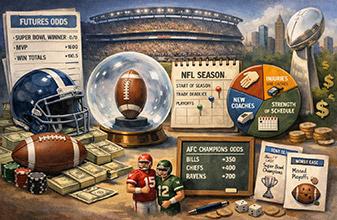Testing W-L records

Sharp Sports Betting is a tool for those interested in winning money at sports betting. The book explains the most common sports bets, what all the numbers mean, and the mathematics behind the numbers.
Let’s discuss some principles of sports betting. All sports bettors should learn the information herein. All other kinds of casino advantage players, including blackjack players of all skill sets, should also have a good working knowledge of Expected Value. You should not be betting online or in land-based casinos without this fundamental knowledge.
The purpose of this segment is to make the application of the methods of statistics to sports betting as easy as possible.
The concept of testing a theory by taking a sample and looking for statistical significance has been around for a long time.
There are three steps. First is formation of the hypothesis. Second is testing the hypothesis. Third is interpreting the results of the test.
Forming the Hypothesis
Start by forming your hypothesis. This means make an explicit statement of what the relationship is that you wish to test.
It is important to pin down all the details of your hypothesis before starting to gather data to test it. For example, you can’t test “Big NFL dogs are good bets” without first defining exactly how big is a big dog.
It’s okay to examine part of your data during the formulation of your hypothesis. You might, for example, examine the results of games played during a specific NFL season to define how big is a big dog. That might help you clarify your hypothesis as “NFL dogs of +5.5 or more are good bets.” You must then throw away those games before beginning the test of your hypothesis. If you used 2021 games to decide to look only at dogs of +5.5 or more, then you can’t use 2021 games to test that hypothesis.
It is best to write down all details of the hypothesis to be sure that it does not get modified in any way during the testing phase.
Testing the Hypothesis
There is a real problem in properly testing hypotheses involving sports: The quantity of data is small. For example, the NFL plays fewer than 300 regular-season games per year. You can get data from football games of years past, but too long-ago games might not be representative of future games, which is what you are trying to predict.
Ideally you should like to test your hypotheses by making predictions for games yet to be played. But that means waiting months or years to generate a sufficient sample size.
It’s acceptable to test your hypothesis against games already played, but remember that the real proof that a system works is its ability to predict future games. Though it’s acceptable to test your hypothesis using a database of games already played, you must do it properly. There are pitfalls that might lead you to think you have discovered a relationship that in fact does not exist. In short, when you are testing using games already played, you may use only games that were not used in any way to formulate your hypothesis.
To be continued…
This is part of an occasional series of articles.
Excerpted with permission from Sharp Sports Betting by Stanford Wong, edited for this format.











Please log in or register to leave a comment